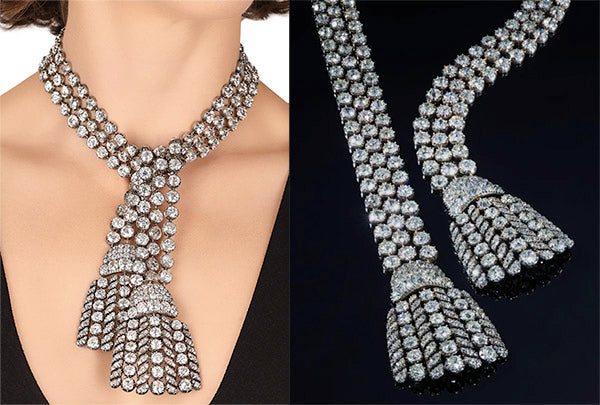A lavish three-strand diamond necklace linked to French aristocracy in the decade leading up to the 1789 French Revolution will be hitting the auction block at Sotheby's Geneva this fall carrying a pre-sale estimate of between $1.8 million and $2.8 million.
“This rare and important diamond jewel is a sublime survivor from the opulent court life of the Georgian era, defined by its unrivaled pomp and splendor. It is arguably one of the most magnificent and intact Georgian jewels in private hands,” said Andres White Correal, chairman of Sotheby’s jewelry Europe and Middle East and head of Noble Jewels.
Boasting a diamond total weight of 300 carats, the three strands terminate at each end with a diamond-embellished tassel. The piece could be worn two ways — draped over the shoulders or tied around the neck in a simple knot. The old mine cut diamonds featured in this piece are believed to have been sourced at the historic Golconda mines in India, which, at the time, were the world's primary source for high-quality stones.
“When compared to other surviving Imperial and Royal jewels from the same period, this necklace stands head and shoulders above these examples," Correal added. "It is a fortune in diamonds, and also a masterclass in exquisite design, workmanship and technical innovation for the period.”
While it is not clear who originally commissioned the piece, based on its opulence, Sotheby's believes the likely owners were members of the French aristocracy or royalty. It is also believed that some of the diamonds making up the piece were plucked from a necklace that was the point of contention in the “1784 Affair of the Diamond Necklace.”
Apparently, Marie Antoinette was accused of failing to pay the Crown jewelers for an opulent diamond necklace, when, in fact, a woman impersonating the Queen of France was really responsible for the fraud.
Nevertheless, the scandal tarnished the Queen's reputation and ultimately led to her demise.
By the early 1900s, the luxurious three-strand diamond had entered the possession of a prominent UK family with ties to the British royal family. In fact, there is photographic evidence of Marjorie Paget, marchioness of Anglesey, wearing the piece at the coronation of British King George VI in 1937. Her daughter-in-law then wore the same jewel to the coronation of Queen Elizabeth II in 1953.
According to Sotheby's, the seventh Marquess of Anglesey parted with the piece in the 1960s. By 1976, it was on exhibit at the American Museum of Natural History in New York City. Later, it was acquired by an "important Asian collector."
The piece is now back in the public eye, with appearances scheduled for London (September 23-25), Hong Kong (October 3-5), New York (October 9-10), Singapore (October 18-19), Taipei (October 21-22) and Dubai (October 28-30). The piece will return to Geneva, where it will headline Sotheby's Royal and Noble Jewels auction on November 11.
Credits: Images courtesy of Sotheby's.


